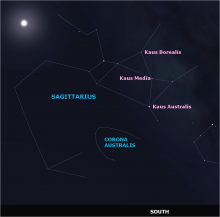Listen to today's episode of StarDate on the web the same day it airs in high-quality streaming audio without any extra ads or announcements. Choose a $8 one-month pass, or listen every day for a year for just $30.
You are here
Hercules
One of the most famous characters in the night sky takes a prominent position at this time of year: Hercules, the strongman. His relatively faint constellation is in view by the time it gets dark, and soars high overhead during the night.
Hercules is the Roman version of a character from Greek mythology. He was the son of a mortal woman and Zeus, the king of the gods. To appease his wife, who was angry at Zeus’s dalliance, Zeus named the boy Heracles, which means “glory to Hera.” But the strategy didn’t work. Hera tormented Heracles throughout his life. To atone for crimes committed while under Hera’s spell, Heracles was forced to perform 12 labors of strength and courage. His labors included killing a lion and a snake, which also stand in the stars.
The most prominent portion of the constellation Hercules is the Keystone — four stars that form a lopsided square. It’s above the northeastern horizon as darkness falls.
Along the line connecting the two stars that rise first, look for a beautiful globular star cluster known as M13. In dark skies, it’s visible to the unaided eye as a faint smudge of light. Binoculars reveal a swarm of stars, while telescopes reveal hundreds of them. In fact, M13 contains hundreds of thousands of stars packed into a tight ball. These stars are among the oldest in the galaxy.
Look for Hercules in the east and northeast at nightfall, and soaring high overhead after midnight.
Script by Damond Benningfield



